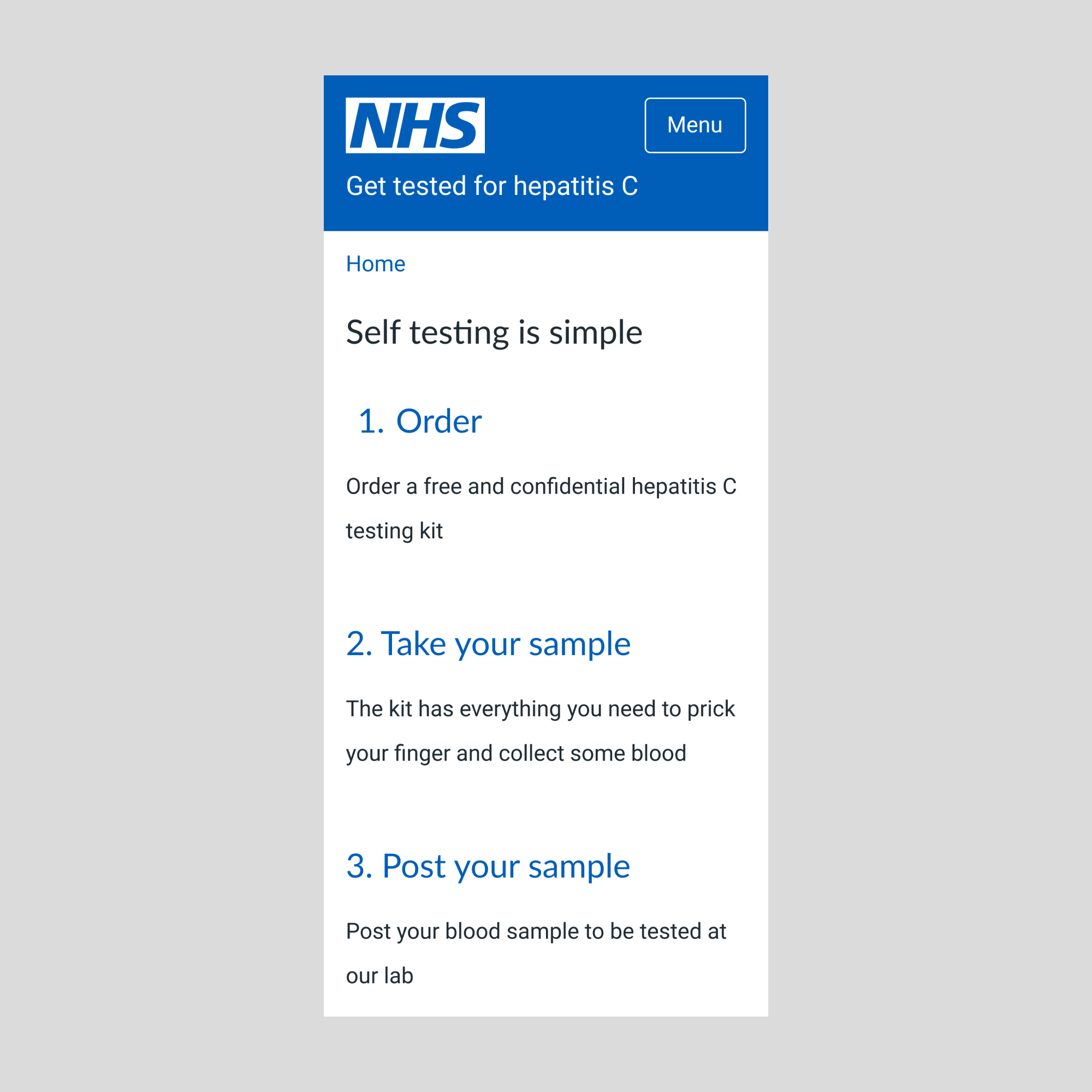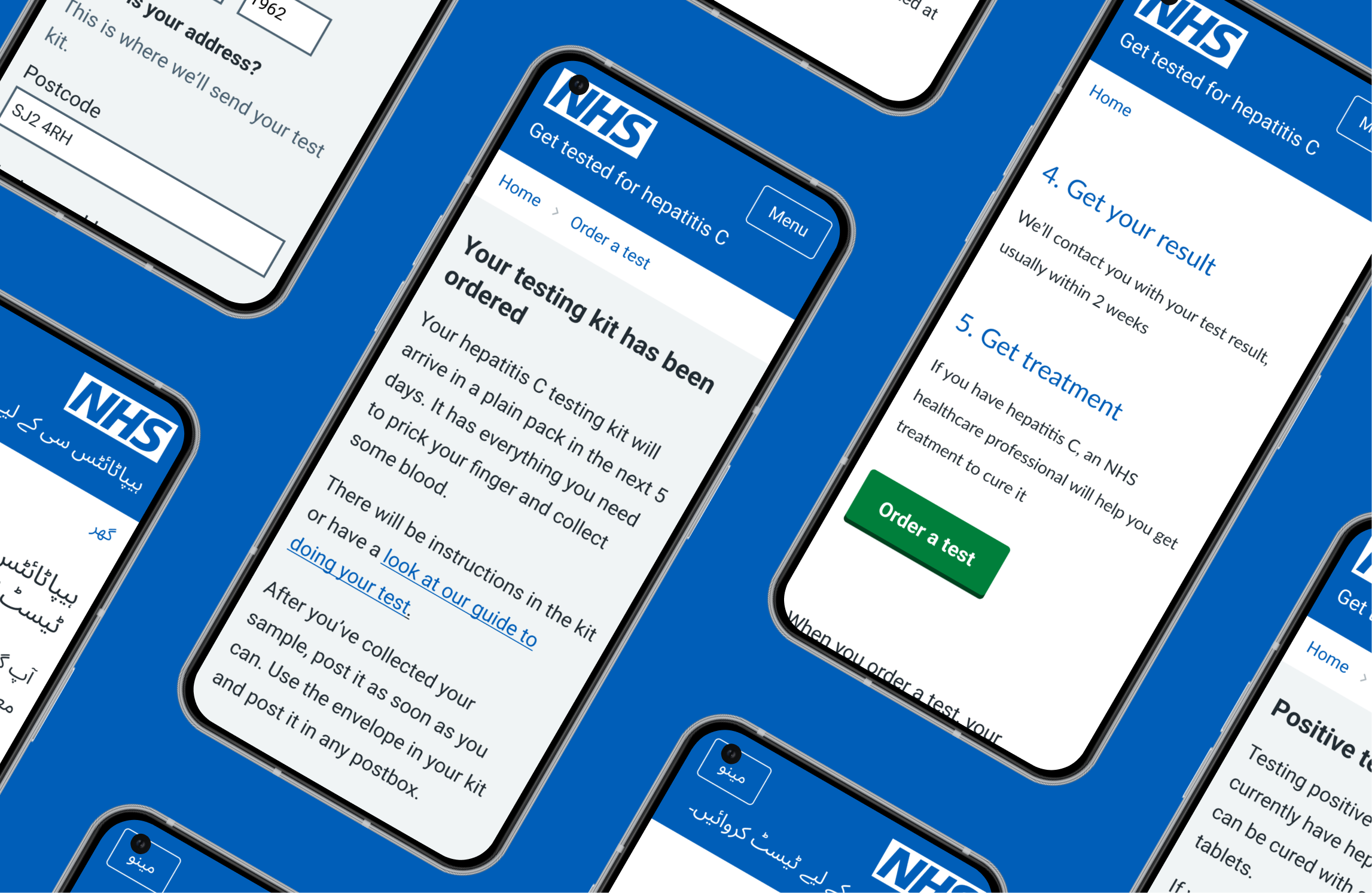

Accessible and inclusive design for NHS service delivery
Developing user-centred service design for a diverse range of target users, in order to eliminate hepatitis C in the UK by 2025.

Situation
Working in partnership with Preventx, NHS England, and the Hepatitis C Trust, nuom were asked to lead the discovery and design phase for a national online portal for self-testing. With the objective to help eliminate hepatitis C in England in advance of the World Health Organization goal of 2030.
In order to create the right digital solution, nuom needed to understand levels of awareness and any barriers that existed within the audience. This meant conducting primary research with key target groups, service providers, and relevant stakeholders, in order to find insights and approaches that would lead to more people getting tested for hepatitis C in England.


Solution
nuom conducted a user-centred discovery phase, which began with a kick-off workshop to agree vision and objectives, followed by stakeholder and clinician interviews and group discussions.
The key user groups to engage with were PWID (people who inject drugs), GBMSM (gay, bisexual, and other men who have sex with men), people from South Asia, and Blood Transfusion service users.
Remote 1-2-1 interviews were carried out, as well as in-person workshops, with all key target user groups. This allowed nuom to fully analyse the perspectives and needs of each group.
Service blueprinting workshops were then carried out, to work with users, providers, and stakeholders, to map out how the service could be best delivered end-to-end.
This in-depth user research helped to prioritise the feature set and UX requirements, enabling the project to move into alpha phase, where nuom carried out three prototype sprints. Each sprint was tested on key target groups to gain feedback, make adjustments, and then retest on the same users to ensure that the iterations were optimal.
At the final prototype stage an Urdu version was also created to cater to South Asian audiences.

Outcome
The key insights unearthed were:
- The need to raise awareness in primary care settings.
- The need to lower the barrier to entry (remove authentication).
- The importance of highlighting treatment options and pathways.
- The need for greater inclusivity and normalised language.
- The need for NHS branding only, in order for people to trust the service.
Therefore, authentication was removed, treatments and pathways were highlighted, a specialist copywriter was used to simplify the language, and NHS-only branding and layout were used without any reference to Preventx, who manage and process the tests on behalf of the NHS.
As per user needs, the service design was mobile-first, with a simplified UX, and minimal copy. This tested exceptionally well with all users, especially those with less digital access or capability.
The final prototype, which worked across desktop and mobile met the Government Digital Service (GDS) Service Standard. At this point the project moved into beta phase, allowing Preventx to build the portal.
“This looks really clear and simple."
"Info like this would ease my anxiety."
"I would definitely consider doing this test."
"The PWID community will definitely see great value in this."
"This will work really well for the South Asian community."
User feedback
Like this? You'll love some of our other projects too
Accessible and inclusive design for NHS service delivery
Developing user-centred service design for a diverse range of target users, in order to eliminate hepatitis C in the UK by 2025.
.png)
Situation
Working in partnership with Preventx, NHS England, and the Hepatitis C Trust, nuom were asked to lead the discovery and design phase for a national online portal for self-testing. With the objective to help eliminate hepatitis C in England in advance of the World Health Organization goal of 2030.
In order to create the right digital solution, nuom needed to understand levels of awareness and any barriers that existed within the audience. This meant conducting primary research with key target groups, service providers, and relevant stakeholders, in order to find insights and approaches that would lead to more people getting tested for hepatitis C in England.

.jpg)


.jpg)
Solution
nuom conducted a user-centred discovery phase, which began with a kick-off workshop to agree vision and objectives, followed by stakeholder and clinician interviews and group discussions.
The key user groups to engage with were PWID (people who inject drugs), GBMSM (gay, bisexual, and other men who have sex with men), people from South Asia, and Blood Transfusion service users.
Remote 1-2-1 interviews were carried out, as well as in-person workshops, with all key target user groups. This allowed nuom to fully analyse the perspectives and needs of each group.
Service blueprinting workshops were then carried out, to work with users, providers, and stakeholders, to map out how the service could be best delivered end-to-end.
This in-depth user research helped to prioritise the feature set and UX requirements, enabling the project to move into alpha phase, where nuom carried out three prototype sprints. Each sprint was tested on key target groups to gain feedback, make adjustments, and then retest on the same users to ensure that the iterations were optimal.
At the final prototype stage an Urdu version was also created to cater to South Asian audiences.


Outcome
The key insights unearthed were:
- The need to raise awareness in primary care settings.
- The need to lower the barrier to entry (remove authentication).
- The importance of highlighting treatment options and pathways.
- The need for greater inclusivity and normalised language.
- The need for NHS branding only, in order for people to trust the service.
Therefore, authentication was removed, treatments and pathways were highlighted, a specialist copywriter was used to simplify the language, and NHS-only branding and layout were used without any reference to Preventx, who manage and process the tests on behalf of the NHS.
As per user needs, the service design was mobile-first, with a simplified UX, and minimal copy. This tested exceptionally well with all users, especially those with less digital access or capability.
The final prototype, which worked across desktop and mobile met the Government Digital Service (GDS) Service Standard. At this point the project moved into beta phase, allowing Preventx to build the portal.
“This looks really clear and simple."
"Info like this would ease my anxiety."
"I would definitely consider doing this test."
"The PWID community will definitely see great value in this."
"This will work really well for the South Asian community."
User feedback

.jpg)


.jpg)

